|
Notes l Bibliography l Download Issue 9 
 |
|
The dense London fog sets the scene for “The Bruce-Partington Plans.” From Collier's Weekly (Dec. 12, 1908), illustrated by Frederic Dorr Steele |
In the third week of November, in the year 1895, a dense yellow fog settled down upon London. (1)
The famous London fogs of years ago have today disappeared completely, thanks to pollution-control laws outlawing the burning of soft coal and requiring tall smokestacks for industrial plants. A temperature inversion, when a stable layer of cold air stalled over the warm city miasma, could make the "fog" (actually smog) immovable for days. In 1952 a particularly bad fog resulted in hundreds, perhaps thousands, of fatalities, mainly among people with respiratory weaknesses. The London fogs have set a mysterious tone for many literary works, among them, Charles Dickens's novel Our Mutual Friend.
There was the news of a revolution, of a possible war, and of an impending change of Government.... (1)
None of these events is easily identifiable. For some possibilities, see Leslie S. Klinger's notes to "The Bruce-Partington Plans" in The New Annotated Sherlock Holmes, vol. 2 (New York: Norton, 2005) 1334-5.
"It is fortunate for this community that I am not a criminal." (1)
Holmes often makes similar observations, and, occasionally, does break the law, as in "The Adventure of Charles Augustus Milverton," by illegally entering someone's lodgings.
"It is well they don't have days of fog in the Latin countries—the countries of assassination." (1)
Holmes's logic does not hold up. Wouldn't there be fewer assassinations in countries that did not have fog? Several hundred years of European colonialism did more to destabilize Latin America than did the weather.
"His Pall Mall lodgings, the Diogenes Club, Whitehall—that is his cycle. Once, and only once, he has been here." (1)
Mycroft visited Baker Street in "The Greek Interpreter." See the notes to that story for maps showing where Mycroft's London haunts lie.
"...and the bimetallic question...." (1)
The question is whether to circulate both silver and gold currency, or to maintain a gold standard, as England did until 1931.
"Well, his position is unique. He has made it for himself. There has never been anything like it before, nor will be again." (2)
The Holmes brothers have created unique positions for themselves, and have made their services indispensable to society.
"But Jupiter is descending to-day."
The Roman god, not the planet, is metaphorically leaving heaven to visit Baker Street.
"...and a clerk at Woolwich Arsenal...." (2)
Located on the Thames River, about nine miles east of London Bridge, the Royal Arsenal was established in Tudor times. In 1910, it employed about 13,000 people, according to Baedeker's London and Its Environs (1911). The Baedeker goes on to call it "one of the most imposing establishments in existence for the manufacture of materials of war."
"...a plate-layer named Mason...." (2)
A "plate-layer" is a railroad worker whose job it is to lay and maintain the rails.
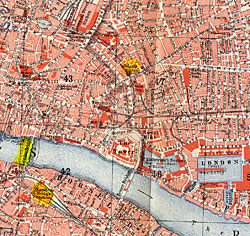 |
|
This map from the 1911 Baedeker's London and its Environs shows the area around Aldgate station. |
"...just outside Aldgate Station on the Underground system in London." (2)
Aldgate Station lies just north of the Tower of London, and northeast of London Bridge. Opened in 1876, Aldgate was a station on the original Metropolitan Line, now just a small branch in the vast London Underground. On the same line, but farther west, lies the Baker Street Station, which opened in 1863, but is never mentioned in a Sherlock Holmes story.
"...those which run from west to east, some being purely Metropolitan, and some from Willesden and outlying junctions." (2)
Conan Doyle is distinguishing between the Metropolitan Line, which ran within London, and trains coming into London from outside the city.
Lying about five miles northwest of Charing Cross, Willesden in Conan Doyle's time was a borough outside of the city of London. Today, it is part of Brent, a borough of Outer London.
"There were also two dress-circle tickets for the Woolwich Theatre...." (3)
The couple probably intended to see a typical British music hall show, consisting of popular songs, comedy, and perhaps juggling or acrobatics.
"In the present state of Siam...." (3)
Thailand was called Siam throughout most of its history. It was never colonized by the British, French, Dutch, or Portuguese, all of whom had interests in the area, but these powers carried on an intense diplomatic rivalry over trade rights with the country. By strategically offering concessions to would-be colonizers, Thailand avoided the fate of its close neighbors in Southeast Asia.
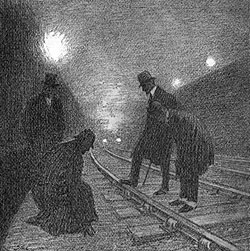 |
|
Holmes examines the rails near Aldgate Station. From Collier's Weekly (Dec. 12, 1908), illustrated by Frederic Dorr Steele |
"You may take it from me that naval warfare becomes impossible within the radius of a Bruce-Partington's operations." (4)
The history of submarines is long and fascinating. By 1900, several countries possessed or were developing small fleets of subs for use in war. At first, the English were not convinced that submarines were "cricket." Honorable men fought each other face to face, clearly flying their nation's flags. Admiral A. K. Wilson declared that the submarine was "underhand, unfair, and damned un-English."
By 1914, England already had the world's largest submarine fleet (74), but Admiral Percy Scott was still attacked in the press as a dreamer when he said that the submarine would change the face of naval warfare. Conan Doyle’s short story, "Danger!" (Strand Magazine, July 1914), shows the consequences of a naval blockade by submarines: mass starvation, leading to a crushing defeat for England in the war. A month after Conan Doyle's story appeared, Germany and England were at war; a month after that, a German "U-boat" sank a British ship with one torpedo. See Brayton Harris, "Four-Hundred Years of Subs" at NOVA Online.
"...a very large sum was smuggled through the Estimates...." (4)
Parliament's proposed budget for the following year is referred to as "the Estimates." Smuggling the amount through without discussing it in Parliament would keep the acquisition of the submarine plans a secret.
"...at Barclay Square...." (4)
There is no Barclay Square in London, but there is a Barclay Street and a Berkeley Square.
Aldgate is a junction, and there was a network of points. (7)
"Points" are railway switches.
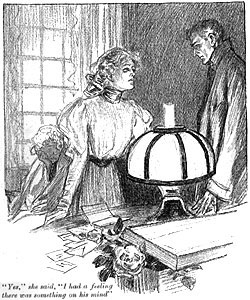 |
|
Holmes talks to Cadogan West's financée. From Collier's Weekly (Dec. 12, 1908), illustrated by Frederic Dorr Steele |
"The double valves with the automatic self-adjusting slots...." (9)
These valves might be meant to allow water in for ballast or to pump it out when rising to the surface, but not enough information is given to tell.
"The only men worth considering are Adolph Meyer, of 13, Great George Street, Westminster; Louis La Rothiere, of Campden Mansions, Notting Hill; and Hugo Oberstein, 13, Caulfield Gardens, Kensington." (11)
Westminster, Notting Hill, and Kensington are all areas in the West-End of London.
"Am dining at Goldini's Restaurant, Gloucester Road, Kensington." (11)
For Holmes, eating at an Italian restaurant would have been considered "slumming." During the mass migration of Italians to England in the mid-19th century, Italians were looked down upon as violent and uncivilized. Two examples of Holmes mysteries involving Italians can be found in the Holmes canon: "The Adventure of the Six Napoleons" (1904) and "The Adventure of the Red Circle" (1911), a story about the mafia.
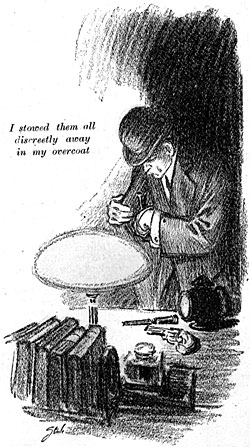 |
|
Watson stashes a set of burglar's tools in his overcoat. From Collier's Weekly (Dec. 12, 1908), illustrated by Frederic Dorr Steele |
"Bring with you a jemmy, a dark lantern...." (11)
A "jemmy" is a crowbar; a covered lantern has a moveable panel that allows light to be directed on a small area.
"We must fall back upon the old axiom that when all other contingencies fail, whatever remains, however improbable, must be the truth." (12)
"It is an old maxim of mine that when you have excluded the impossible, whatever remains, however improbable, must be the truth," Holmes says in "The Adventure of the Beryl Coronet" (1892).
"I began my operations at Gloucester Road Station...." (12)
Gloucester Road Station in South Kensington is a station of the London Underground that opened in 1868.
...one of those lines of flat-faced, pillared, and porticoed houses which are so prominent a product of the middle Victorian epoch in the West-end of London. (12)
A portico is a covered porch. Today, these look-alike Victorian houses are in great demand in the housing market.
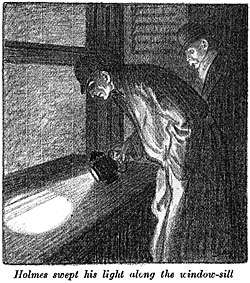 |
|
Holmes examines a windowsill at the suspect's home. From Collier's Weekly (Dec. 12, 1908), illustrated by Frederic Dorr Steele |
"We would do better in the area." (12)
The "area" is a window well, or, as in this case, a basement entrance meant for tradesmen and servants. It would have been surrounded by a railing. The uncarpeted stairs that Holmes and Watson climb were also meant for the servants.
"Daily Telegraph agony column by the print and paper." (14)
"The agony column" is a flippant reference to personal ads, in which all sorts of human dramas were acted out. The Daily Telegraph used a box-number system for its personal ads, in which both advertiser and respondent were able to keep their anonymity.
As he told Watson in The Hound of the Baskervilles, Holmes can identify all the English newspapers by their print and paper.
"—Pierrot." (14)
Pierrot is a character of French pantomime introduced by the actor Jean Gaspard Deburau (1796-1846), and derived from the ancient stock character of the sad fool. Deburau wore an overlarge white costume with big buttons and painted his face white—a precursor of the modern clown costume.
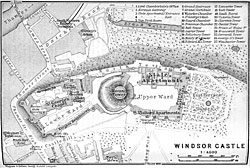 |
|
This map of Windsor Castle comes from Baedeker's London and its Environs (1911), which devotes over five pages to describing the castle's attractions. |
...a monograph which he had undertaken upon the Polyphonic Motets of Lassus. (14)
Renaissance motets are choral compositions based on a sacred text. They have a polyphonic structure, which means that several voices of equal weight sing together in counterpoint. (The term "polyphonic motets" is redundant.) A motet differs from a madrigal mainly in that the former is based on a sacred text, the latter on a secular text.
Orlande de Lassus (1532?-1594) was a Flemish-born composer known for his choral compositions and songs. A cosmopolitan artist, he lived all over Europe, composing works in French, German, and Italian. Many examples of his masses have survived, as well as motets, madrigals, and various other songs, but performances of his works are extremely rare.
"...a short life-preserver." (16)
A "life-preserver" is not the familiar ring thrown to drowning sailors, but a club, used as a weapon of self-defense.
 |
|
In the American edition, the ending of "The Bruce-Partington Plans" is squeezed between columns of ads for everything from shoes to automobiles. From Collier's Weekly (Dec. 12, 1908) |
"...the Hotel du Louvre, Paris...." (16)
Built in 1855, the Hôtel du Louvre still lies across the street from the Louvre Museum in Paris.
"...the Charing Cross Hotel...." (17)
Built in Victorian times, the Charing Cross Hotel is located on The Strand, just adjacent to Charing Cross Station.
Some weeks afterwards I learned incidentally that my friend spent a day at Windsor, whence he returned with a remarkably fine emerald tie-pin. (17)
Windsor Castle, in the town of Windsor, is the official residence of the reigning English monarch. The first castle on this site was built by William the Conqueror nearly a thousand years ago. Under Queen Victoria's reign, an extensive renovation was completed, and parts of the castle were opened to the public. Windsor is located 25 miles due west of London.
Victoria, who reigned from 1837 to 1901, must be the queen who presented Holmes with his emerald tie-pin, since the story takes place in 1895.
In the 1925 story, "The Three Garridebs," Watson reports that Holmes refused a knighthood in the same month (June 1902) that Conan Doyle was knighted for his energetic support of the British position in the Boer War.
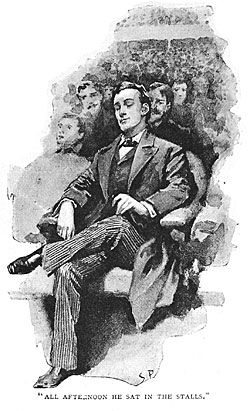 |
|
Sidney Paget's drawing of a young, handsome Holmes at the symphony, from "The Red-Headed League" (The Strand, 1891) |
Arthur Conan Doyle created Sherlock Holmes, but Sidney Paget gave him a face. Since the last years of the 19th century, every visual representation of Holmes has begun from Paget's conception of the thin detective with aquiline features. Paget illustrated all the Holmes stories that appeared in The Strand until Holmes's death in "The Final Problem," and was specifically requested by Conan Doyle for The Hound of the Baskervilles. In all, Paget illustrated 37 Holmes stories and one novel. Not bad, considering that he received the original commission erroneously; The Strand 's publishers had meant to send it to his younger brother Walter.
Upon Paget's death in January 1908, The Strand 's publishers decided to choose a variety of artists to work on the next group of Conan Doyle stories, collected as His Last Bow. Arthur Twidle illustrated "The Bruce-Partington Plans" much as Sidney Paget had—in dramatic chiaroscuro, with a Holmes who resembled Paget's. Sidney's brother Walter illustrated "The Dying Detective"; Gilbert Holiday, "The Devil's Foot" and "His Last Bow." Other illustrators for stories in His Last Bow were Alec Ball and the team of H.M. Brock and Joseph Simpson. The Case-Book of Sherlock Holmes, which turned out to be the final volume of Holmes stories, was illustrated by Howard Elcock, Gilbert Holiday, and Frank Wiles.
When the stories were reissued in America, then in other countries, new illustrators were chosen—notably, Frederic Dorr Steele in the United States. Over the years, a multitude of artists around the world have tried their hands at portraying Holmes and Watson.
For examples of the work of these artists and others, see Nancy Blakestad and David Soucek's website, "Pinacotheca Holmesiana," Camden House: the Complete Sherlock Holmes.
|










